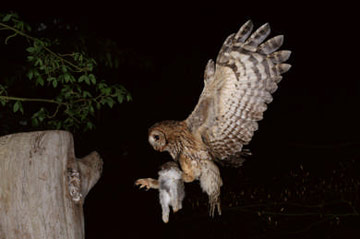
Tawny Owl © Andy Harmer
This is the woodland owl, and Tawny Owl distribution shows a strong correlation with woodland cover. Two-thirds of the habitat codes submitted were category A (woodland), all but a handful of them A1 (broad-leaved) or A3 (mixed). Provided that there are sufficient trees, even large gardens are occupied in some areas, and in 53 tetrads, habitat codes for human sites were recorded, 5 urban, 25 suburban and 23 rural. The Atlas map shows that Tawny Owls have significantly contracted in range since our First Atlas, mainly retreating into their core wooded areas.
Tawny Owls hunt mostly by waiting on a perch then pouncing when they hear some movement below. Their main prey is small mammals, especially wood mice and bank voles, with shrews and moles. Some individuals are adept at catching frogs, and others take a surprisingly high proportion of earthworms and beetles, especially when they have hungry chicks to feed. Birds, of any size from Jay to Wren, may comprise 10% of their diet, with urban and suburban owls taking far more birds than rural ones.
They nest in a hole or ledge, or an old nest of a corvid or raptor, or a squirrel’s drey. Nest-boxes are also used, and are perhaps especially good for them, because Tawny Owls often seem to choose a natural site with a shallow entrance from which over-adventurous half-grown chicks can fall out of the nest, often with fatal consequences unless the bird can climb back high enough to be safe from predators.
The typical timing is for Tawny Owls to lay their first egg around the third week of March, with chicks hatching 30 days later and fledging around the end of May. Odd pairs may nest much earlier than that, however, and chicks in March are reported every year. The average brood size is two chicks. Two-thirds of the 95 confirmed breeding records came from observers finding recently-fledged chicks, often alerted to them by their plaintive hunger calls.
Although all nocturnal species are liable to be under-recorded, the sound of its loud hooting is noticeable and carries a long way. A number of records were passed on to surveyors by interested landowners. Their ‘tu-whit, to-whoo’ call is unmistakeable, except that many people wrongly think that one sex gives one call and one the other. Most observers initially located Tawny Owls by sound, but some had their attention drawn by a bout of persistent mobbing by small birds who found an owl’s daytime roost.
Tawny Owl is poorly covered by the national monitoring schemes, but they suggest a shallow decline, perhaps a 25% drop between our two Atlas periods. Breeding was confirmed in 100 tetrads and probable in a further 34, and many of the 180 tetrads with possible breeding must hold at least one pair of this under-recorded species. Even if there is only one pair per tetrad, and allowing for some double-counting of their far-carrying calls, the county total must be at least 250 pairs. This would be just half of the figure in the First Atlas of 550 pairs.
Sponsored by John Patterson

